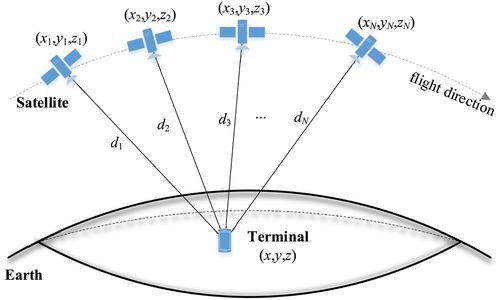当前位置:
X-MOL 学术
›
Int. J. Satell. Commun. Netw.
›
论文详情
Our official English website, www.x-mol.net, welcomes your
feedback! (Note: you will need to create a separate account there.)
Terminal location method with NLOS exclusion based on unsupervised learning in 5G‐LEO satellite communication systems
International Journal of Satellite Communications and Networking ( IF 0.9 ) Pub Date : 2020-03-16 , DOI: 10.1002/sat.1346 Feng Zhu 1 , Teer Ba 1 , Yuan Zhang 1 , Xiqi Gao 1 , Jiang Wang 2
International Journal of Satellite Communications and Networking ( IF 0.9 ) Pub Date : 2020-03-16 , DOI: 10.1002/sat.1346 Feng Zhu 1 , Teer Ba 1 , Yuan Zhang 1 , Xiqi Gao 1 , Jiang Wang 2
Affiliation

|
We investigate the terminal location method in 5G‐Low Earth Orbit (5G‐LEO) satellite communication systems. To overcome the dependence on the external Global Navigation Satellite System (GNSS), we propose to use a single LEO satellite in 5G‐LEO satellite communication systems for terminal location and utilize the downlink synchronization detection for pseudorange differential measurement. Then, a data clustering method of unsupervised machine learning is proposed to classify the measured data into line‐of‐sight (LOS) and non‐line‐of‐sight (NLOS) signals. Furthermore, the NLOS data are excluded, and the Taylor series expansion iteration method is used to calculate the terminal coordinates. Simulation results show that the proposed method can effectively reduce the influence of NLOS error on measurement results and improve the accuracy of terminal location. In simulated urban scenario, the average location accuracy is improved from 10 km by traditional methods to 0.7 km and the convergence time is reduced from 400 to 250s.
中文翻译:

基于5G-LEO卫星通信系统无监督学习的NLOS排除终端定位方法
我们研究了5G低地球轨道(5G-LEO)卫星通信系统中的终端定位方法。为了克服对外部全球导航卫星系统(GNSS)的依赖性,我们建议在5G-LEO卫星通信系统中使用单个LEO卫星进行终端定位,并利用下行链路同步检测进行伪距差分测量。然后,提出了一种无监督机器学习的数据聚类方法,将测量数据分为视线(LOS)和非视线(NLOS)信号。此外,将NLOS数据排除在外,并使用泰勒级数展开迭代法计算终点坐标。仿真结果表明,该方法可以有效减少非视距误差对测量结果的影响,提高终端定位精度。在模拟的城市场景中,平均定位精度从传统方法的10 km提高到0.7 km,收敛时间从400s减少到250s。
更新日期:2020-03-16
中文翻译:

基于5G-LEO卫星通信系统无监督学习的NLOS排除终端定位方法
我们研究了5G低地球轨道(5G-LEO)卫星通信系统中的终端定位方法。为了克服对外部全球导航卫星系统(GNSS)的依赖性,我们建议在5G-LEO卫星通信系统中使用单个LEO卫星进行终端定位,并利用下行链路同步检测进行伪距差分测量。然后,提出了一种无监督机器学习的数据聚类方法,将测量数据分为视线(LOS)和非视线(NLOS)信号。此外,将NLOS数据排除在外,并使用泰勒级数展开迭代法计算终点坐标。仿真结果表明,该方法可以有效减少非视距误差对测量结果的影响,提高终端定位精度。在模拟的城市场景中,平均定位精度从传统方法的10 km提高到0.7 km,收敛时间从400s减少到250s。











































 京公网安备 11010802027423号
京公网安备 11010802027423号